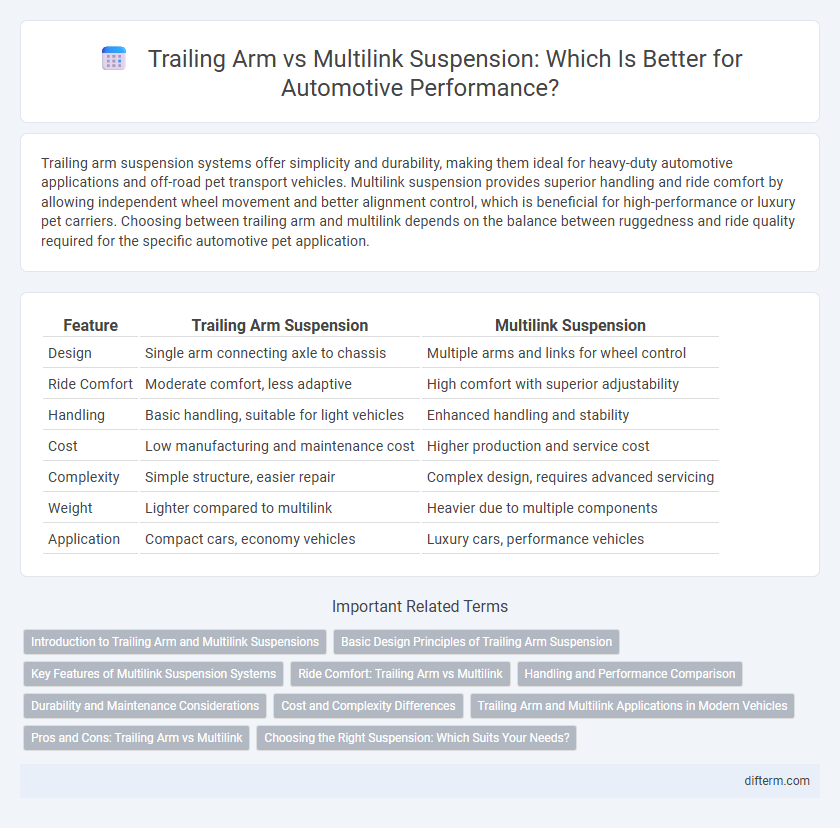Trailing arm suspension systems offer simplicity and durability, making them ideal for heavy-duty automotive applications and off-road pet transport vehicles. Multilink suspension provides superior handling and ride comfort by allowing independent wheel movement and better alignment control, which is beneficial for high-performance or luxury pet carriers. Choosing between trailing arm and multilink depends on the balance between ruggedness and ride quality required for the specific automotive pet application.
Table of Comparison
| Feature | Trailing Arm Suspension | Multilink Suspension |
|---|---|---|
| Design | Single arm connecting axle to chassis | Multiple arms and links for wheel control |
| Ride Comfort | Moderate comfort, less adaptive | High comfort with superior adjustability |
| Handling | Basic handling, suitable for light vehicles | Enhanced handling and stability |
| Cost | Low manufacturing and maintenance cost | Higher production and service cost |
| Complexity | Simple structure, easier repair | Complex design, requires advanced servicing |
| Weight | Lighter compared to multilink | Heavier due to multiple components |
| Application | Compact cars, economy vehicles | Luxury cars, performance vehicles |
Introduction to Trailing Arm and Multilink Suspensions
Trailing arm suspensions use a single arm connected to the chassis that pivots to allow vertical wheel movement, providing durability and simplicity ideal for rear-wheel-drive vehicles. Multilink suspensions consist of multiple arms and links, enabling precise control over wheel alignment and improved handling dynamics by allowing independent adjustment of camber, toe, and caster angles. Both systems impact ride comfort and vehicle stability, with trailing arm favoring ruggedness and multilink offering superior performance in handling and road adaptability.
Basic Design Principles of Trailing Arm Suspension
Trailing arm suspension features a rigid arm connected to the chassis at one end and the wheel hub at the other, allowing vertical wheel movement while maintaining axle alignment. Its basic design emphasizes simplicity, durability, and cost-effectiveness, often using a single pivot point to control wheel motion. This design contrasts with multilink suspension, which uses multiple arms for enhanced wheel control and ride comfort.
Key Features of Multilink Suspension Systems
Multilink suspension systems offer superior wheel control through multiple independent arms that precisely manage camber, toe, and caster angles for enhanced handling and ride comfort. Their design allows for better absorption of road irregularities, reducing noise and vibration for a smoother driving experience compared to the simpler trailing arm setups. By enabling optimal tire contact with the road surface, multilink systems improve traction, stability, and overall vehicle dynamics in both high-performance and everyday driving scenarios.
Ride Comfort: Trailing Arm vs Multilink
Trailing arm suspension generally offers simpler design and moderate ride comfort by allowing controlled vertical wheel movement but may transmit more road shocks to the cabin. Multilink suspension provides superior ride comfort through its multiple independent arms that precisely manage wheel alignment and absorb road irregularities more effectively. The multilink system's enhanced ability to isolate vibrations and optimize tire contact significantly improves overall driving smoothness compared to trailing arm setups.
Handling and Performance Comparison
Trailing arm suspensions offer simpler design and durability, providing stable handling on rough roads but limited adjustability in wheel movement. Multilink setups enhance handling precision through independent control of wheel angles, enabling better traction, cornering performance, and ride comfort. High-performance vehicles favor multilink systems for superior adaptability and optimized dynamic response in various driving conditions.
Durability and Maintenance Considerations
Trailing arm suspensions offer greater durability due to their simpler design and fewer moving parts, reducing wear and tear over time. Multilink suspensions provide enhanced ride quality and handling but require more frequent maintenance because of multiple joints and bushings prone to wear. Choosing between the two systems depends on prioritizing long-term durability versus performance and regular service intervals.
Cost and Complexity Differences
Trailing arm suspensions generally incur lower costs due to simpler design and fewer components compared to multilink systems, which involve multiple arms and bushings. The reduced complexity of trailing arm setups translates into easier manufacturing and maintenance, minimizing overall expenses. Multilink suspensions, while offering superior handling and adjustability, require more sophisticated engineering and precision, driving up both production and repair costs.
Trailing Arm and Multilink Applications in Modern Vehicles
Trailing arm suspensions offer simplicity and durability, making them ideal for rear-wheel-drive trucks and SUVs where load-bearing and off-road capability are prioritized. Multilink suspensions, featuring multiple control arms, provide superior wheel control and ride comfort, commonly used in performance cars and luxury vehicles to enhance handling and passenger comfort. Modern vehicles often combine these systems to optimize stability, tire contact, and adaptability to diverse driving conditions.
Pros and Cons: Trailing Arm vs Multilink
Trailing arm suspension offers a simple design with fewer components, resulting in lower manufacturing costs and easier maintenance but can compromise ride comfort and handling precision due to limited wheel control. Multilink suspension provides superior handling, ride quality, and adaptability by allowing independent wheel movement and precise geometry adjustments; however, it is more complex, heavier, and expensive to produce and maintain. Choosing between trailing arm and multilink systems depends on balancing cost efficiency with the desired level of driving dynamics and comfort.
Choosing the Right Suspension: Which Suits Your Needs?
Trailing arm suspension offers simplicity and durability, ideal for vehicles prioritizing rugged performance and load-bearing capabilities. Multilink suspension provides superior handling and ride comfort by allowing independent wheel movement, making it suitable for sports cars and luxury vehicles. Selecting the right suspension depends on your driving style, vehicle type, and desired balance between comfort and control.
trailing arm vs multilink Infographic

 difterm.com
difterm.com